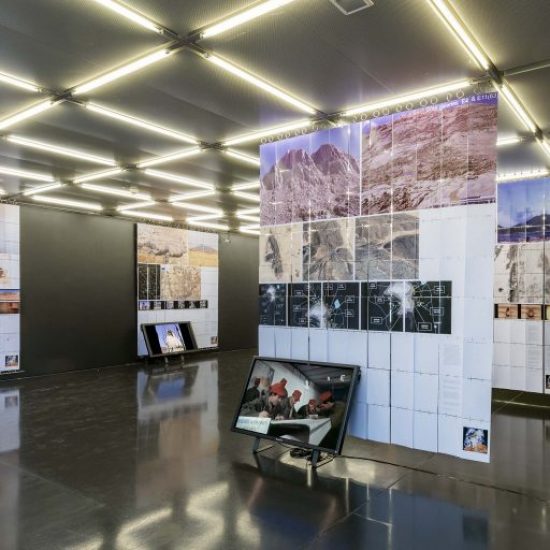The exhibition sheds light on the redacted history of French nuclear colonialism in the Algerian Sahara and draws attention to the urgency of reckoning with this history and its lived environmental and sociopolitical impacts. It was produced by Framer Framed, Amsterdam, in collaboration with If I Can’t Dance, I Don’t Want To Be Part Of Your Revolution, Amsterdam.
Between 1960 and 1966, the French colonial regime detonated four atmospheric atomic bombs, thirteen underground nuclear bombs and conducted other nuclear experiments in the Algerian Sahara, whose natural resources were being extracted in the process. This secret nuclear weapons programme occurred during and after the Algerian Revolution, or the Algerian War of Independence (1954–62). The resulting toxification of the Sahara spread radioactive fallout across Algeria, North, Central and West Africa, and the Mediterranean (including Southern Europe), causing irreversible and still ongoing contaminations of living bodies, cells and particles, as well as in the natural and built environments. Because the archives of the French nuclear programme remain closed over fifty years later, historical details and continuing impacts remain largely unknown.
The exhibition “Performing Colonial Toxicity” presents available, offered, contraband and leaked materials from these archives in an immersive multimedia installation. It creates with them a series of audio-visual assemblages, which trace the spatial, atmospheric, and geological impacts of France’s atomic bombs in the Sahara, as well as its colonial vocabularies, and the (after)lives of its radioactive debris and nuclear waste. Taking on an architectural scale, these “stations,” as Henni refers to them, are meant to be moved through and engaged with. Visitors are invited in to draw their own connections between what is present in the installation, as well as what is absent from it.
Experimenting with different methods of spatialising and circulating suppressed information, the project’s three-part structure constitutes a powerful call to action to open the still-classified archives and to clean/decontaminate the sites: both crucial steps for exposing the pasts, presents and futures of colonial toxicity. The exhibition emerges from a broader research project, which also includes an open access digital database entitled The Testimony Translation Project, and the publication Colonial Toxicity: Rehearsing French Radioactive Architecture and Landscape in the Sahara. This publication brings together nearly six hundred pages of materials documenting this violent history of France’s nuclear bomb programme in the Algerian desert. Meticulously culled together by the architectural historian Samia Henni from across available, offered, contraband, and leaked sources, the book is a rich repository for all those concerned with histories of nuclear weapons and engaged at the intersections of spatial, social and environmental justice, as well as anticolonial archival practices.
at gta exhibitions — ETH Zurich
until April 2, 2024


